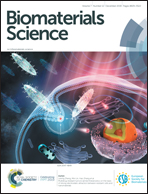A nano-immunotraining strategy to enhance the tumor targeting of neutrophils via in vivo pathogen-mimicking stimulation†‡
Abstract
Due to unsatisfactory tumor-targeting efficiency, hitch-hiking nanomedicines with tumor “smelling” immune cells have rapidly evolved to achieve a more precision delivery. However, the current research tends to default to the smelling capacity of neutrophils and largely overlooks the capacity of those immune cells that are heavily dependent on the pathogen exposure history of individuals. By avoiding risky strategies, such as altering the housing environment of mice for the improved activity of immune cells, we propose a new concept of nano-immunotraining strategy to quickly activate neutrophil tumor tropism and thereby give an enhanced tumor-targeting capacity. Such a strategy involves a facile construction of a vaccine-like nano-CpG adjuvant, followed by pre-immunizing on mice periodically to mimic the pathogen exposure. The results demonstrated that a significantly enhanced tumor-targeting accumulation of neutrophils harvested from nano-immunotrained mice could be achieved, either by intraperitoneal or intravenous injection. This easily accessed, reproducible, and biosafe nano-immunotraining strategy holds a great promise for more precision delivery of nanomedicines.



 Please wait while we load your content...
Please wait while we load your content...